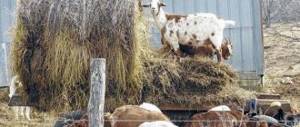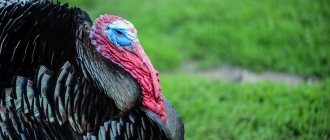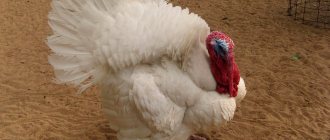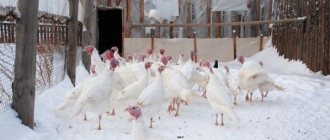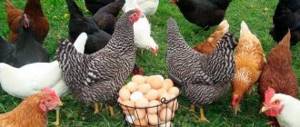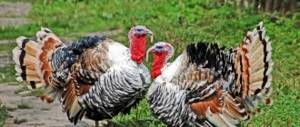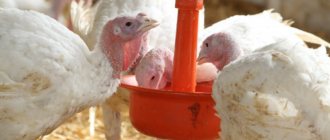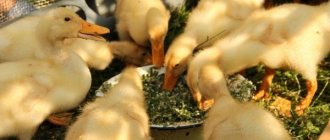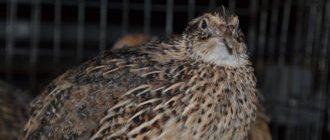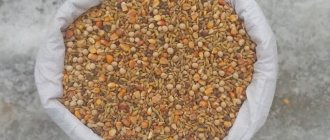Secrets of gaining body weight in turkeys
It is known that a large bird with good meat is, first of all, a healthy bird. Intensive growth of individuals is possible only if the recommendations for keeping and organizing the daily routine of birds are followed. Here are the basic simple rules:
Cleanliness in the poultry house is the key to health
Timely disinfection of the poultry house and perches, as well as daily cleaning of water trays and feeders, helps maintain the health of all members of the flock. You need to be careful about the hygiene of the feeding area, because it is particles of contaminated food and drink that cause diseases such as diarrhea, infections with roundworms and tapeworms, and indigestion in birds.
About
How long does a turkey grow?
Many farmers agree that most modern breeds of broiler turkeys take about four months to grow. It is after this age that they stop gaining body weight. Further, keeping and feeding these domestic birds is simply considered economically unprofitable.
Of course, you can continue to fatten turkeys, but the gain in body weight will not be due to the increase in protein meat and muscles, but due to the appearance and growth of the fat layer. Since turkey is a dietary meat and is highly valued on the market precisely because of these properties, the fat layer will significantly reduce the price of the product.
Upon reaching four months, the body weight of an adult male is seven to eight kilograms. If the farmer decides to raise the poultry further, in a year he can get a bird weighing twenty to thirty kilograms.
To minimize the accumulation of fat in a turkey, you need to include as many protein foods as possible in the diet and keep carbohydrates to a minimum. You should also organize a walking regime for the birds. This measure will serve to prevent obesity.
Age characteristics of the bird
The period of raising young animals is discussed on specialized websites and forums. Many people say that fattening is carried out until the bird reaches productive weight. This means that individuals begin to be used for meat when their body weight exceeds 3 kg.
This indicator is considered productive weight, but not many people allow a turkey chick with such a small body weight to be slaughtered: it continues to grow and rapidly gain body weight. The growth and development of young animals is uneven. Body weight depends on the sex and age of turkey poults. Beginners in poultry farming need to know how long a turkey grows in order to effectively use the food supply.
The incubation period lasts 28 days. After all the chicks have shed their shells, they are left in the incubator to dry. Then they are transferred to cages or to bedding under the brooder. Maintains initial temperature of 35-37 C.
Chicks receive their first food 4-6 hours after birth. They are fed calcium gluconate and given a boiled egg: 1 turkey egg per 30 heads. After 2 hours, add cottage cheese and yogurt to the egg. Next, millet is introduced. Total amount of feed 10 g.
On the 2nd day, add greens from the garden or finely chopped carrots to the food. The chickens are prepared with mash with yogurt or skim milk. From 3-5 days, the chicks can be given mixed feed. How long does it take to raise turkeys? The growing time depends on the physiological characteristics of the breed:
- For fattening, chicks with an average weight of 60 g are selected. It is immediately recommended to divide the livestock into males and females. Rearing males require more food. In the first days, their weight remains constant, but after a week they notice high growth. The development is almost the same in both light-line turkey chicks and heavy-breed chicks. In 2 weeks they gain up to 100 g. Their weight is 150-160 g. Moreover, females have a larger body weight than males;
- By week 4, growth hormone levels in turkeys decrease. In males, on the contrary, its concentration increases. Males develop faster than females. By the 4th week, the weight of females is 380 g, the body weight of males is 440 g. Raising broiler crosses is a more profitable enterprise. At 4 weeks, males can weigh up to 1.5 kg. Individuals BIG-6, bronze-708, Hybrid Converter are distinguished by their high weight;
- Accelerated muscle mass gain occurs up to 9 weeks. At this time, turkeys gain 1.2 kg, males 1.4 kg. Young broiler crosses gain up to 6 kg. The livestock can be sold, but each poultry farmer decides independently how long to raise turkeys. For meat production, broiler breeding is a more profitable enterprise. Subsequently, development in young animals slows down, but individuals still continue to grow;
- at 10 weeks the weight is 1.8-2 kg. Broiler crosses gain more than 7 kg. The weight of the carcass is 5 kg. Young animals are slaughtered for meat;
- at 12 weeks – 2.4-2.9 kg. The body weight of a heavy breed bird is more than 9 kg;
- 14 weeks – 2.9-3.8 kg. Broiler weight 12.61-13 kg;
- 16 weeks – 3.4-4.6 kg. This is a good productive weight, but many backyard keepers do not want to use birds: they may still grow and reach their maximum weight. Hybrid individuals weigh a lot. Meat productivity is more than 15 kg: young animals can be slaughtered for meat;
- subsequently, the differences between females and males become more and more noticeable. Turkeys do not gain weight as quickly as males. At 18 weeks females reach 3.9 kg, males - 5.5 kg. Meat yield 3.5 kg. Broiler turkeys are sold earlier for meat; the livestock is usually not raised until 18 weeks. Their body weight reaches 18-19 kg. The carcass will weigh 15.3 kg. Such a large carcass is not in demand among consumers. The indicator is decent, but many poultry farmers do not stop at this result. How long will it take them to raise the turkeys to their maximum production;
- at 20 weeks, individuals experience puberty. At this time, the birds begin to grow rapidly again and gain weight rapidly. By week 20, the weight reaches 4.4 kg. Males weigh 6.5 kg. Broilers gain more than 20 kg. They do not form the parent herd, so feeding them for a long period is unprofitable. They require a lot of food;
- The development of reproductive organs continues for up to 30 days. At 26 weeks, females gain 5.4 kg, males weigh more than 9 kg. Hybrid individuals can weigh 25-30 kg. Their development stops;
- subsequently, individuals do not differ in accelerated growth. The level of growth hormone begins to gradually decrease. The hormone reaches its minimum concentration in birds aged 34-36 weeks. By this time the weight is 6.5-12 kg.
More on the topic: What is the difference between a female turkey and a male one?
These indicators are typical for livestock of the average weight group. They are most in demand among poultry farmers: the individuals are unpretentious and can be kept in cages. The weight of heavy line birds by 34 weeks reaches 25 kg for males, 18 kg for females. Young animals of heavy breeds are kept only on bedding. They are not suitable for cage keeping.
It is recommended to keep purebred turkeys for up to 7-9 months, while hybrid turkeys are raised for up to 4 months. Next, the livestock is used for meat. Longer fattening will require larger financial investments. The use of feed is not effective. Turkeys are usually kept to their maximum weight during pasture-fed livestock, when feed costs are minimal. At 36 weeks, the bird stops growing. Turkeys reach their maximum weight: they will not grow any further.
To breed turkeys for meat, young hybrid crosses are purchased. Poultry farmers are interested in how long turkeys grow before slaughter. If the farm raises individuals of medium weight category, then it is advisable to start selling young animals at the age of 20 weeks. Broilers are raised up to 4 months of age.
Record holders among turkeys
As it became clear from the article, it depends directly on the farmer how much to fatten domestic birds before slaughter. However, most turkey owners agree that it is not advisable to feed the birds after four to six months.
The birds will gain weight in the future, but the cost of food consumed and the benefit received at slaughter are not comparable. It is cheaper to slaughter poultry for meat after reaching sexual maturity.
Of course, there are cases when turkeys are left for further breeding. As a rule, these are two or three of the strongest males. Females can be kept for up to a year; it is after this period that they reach the peak of egg production and egg fertilization.
About
Livestock maintenance
Poultry farmers need to decide what technique to use to fatten turkeys. Chicks from the brooder can be transferred to cages, bedding, or an outdoor aviary. The diet of individuals depends on the maintenance of the livestock. If the young animals are kept in cages, then fattening is carried out with dry food. It begins to be given to chicks from the 5th day of life:
- up to 5 weeks, turkey poults eat mash from the pre-start version of the feed. The initial amount is 10 g. By week 5, the amount of dry mixture is increased to 90 g;
- From 6 to 13 weeks, starter versions of the feed are used. The volume of the mixture grows from 120 to 265 g;
- At 14-17 weeks, preparations are underway for finishing fattening. Teen feed lines are used. A serving is 280-325 g;
- 18-30 weeks is the last stage of fattening the bird. The serving size is 220-280 g. Growth in turkeys gradually slows down and stops by 36 weeks.
More on the topic: How to build a nest for a turkey with your own hands?
If traditional diets are used when raising livestock, then grain mixtures based on corn, wheat, peas and barley are used for fattening. It is recommended to add buckwheat and peeled oats to grain complexes. In addition to grain mixtures, green grass, vegetables, mineral and vitamin supplements, and protein fillers are introduced into the diet.
With combined feeding, some part of the diet is replaced with dry mixtures from the manufacturer. Their volume is 30%. Mineral salts, vitamins and high-calorie fillers are not added to the diet. Everything you need is contained in the finished product:
| № | Helpful information |
| 1 | at 10 days the chicks receive 40 g |
| 2 | at 20 days – 160 g |
| 3 | per month – 320 g |
| 4 | at 2 months – 400 g |
| 5 | Then they look at the bird’s behavior, appetite and activity. Individuals are able to independently regulate their food intake. By the age of 4 months, heavy males can consume up to 600 g of nutritional mixture or from 800 g to 1 kg of the traditional diet |
Turkeys are very sensitive to living conditions. They are whimsical and demanding. They show good growth and high productivity if all sanitary standards and a certain microclimate are observed in the poultry house. The optimal room temperature is 16-18 C, humidity 55%. The poultry house must be constantly ventilated. A lack of oxygen will immediately affect the health of turkeys.
Igor Nikolaev
auto RU
The duration of daylight hours is 14-16 hours, but the regime is changed a month before slaughter. In order for individuals to quickly gain weight, the length of the day is reduced. The lights are turned off after each feeding. Metabolism in birds slows down and activity decreases. These activities contribute to weight gain. It is not necessary to constantly keep the herd in this mode. Birds can deposit large amounts of subcutaneous fat. This will affect the quality of the meat.
How long to keep a turkey fattening depends on poultry farmers. They decide at what age to bring young animals to slaughter. The optimal period is 7-9 months. Broiler crosses reach their good productivity at 4 months.
More on the topic: What kind of care do turkey chickens require?
If you wish, you can raise a bird of maximum weight, but this will require additional funds. In addition, turkeys weighing up to 8-10 kg are in demand among consumers. From the 26th week, growth in birds slows down. By 34 weeks, development stops. Turkeys continue to be kept only for yard decoration.
